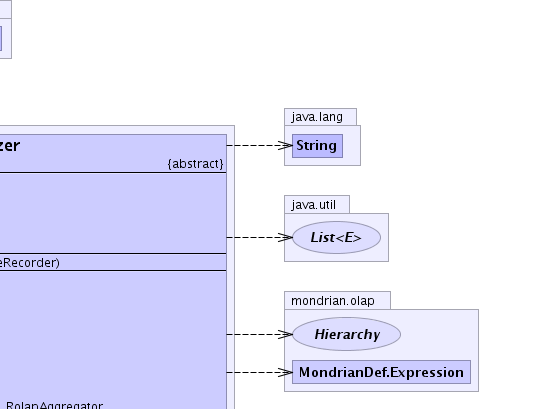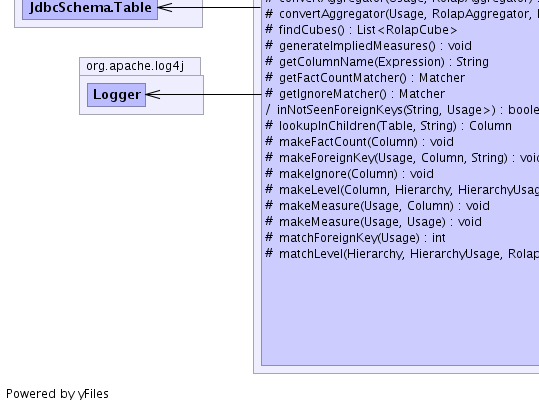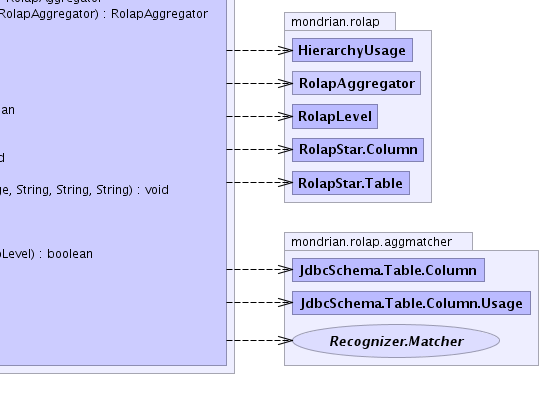 mondrian.rolap.aggmatcher.Recognizer
mondrian.rolap.aggmatcher.Recognizer
|
|||||||||
| PREV CLASS NEXT CLASS | FRAMES NO FRAMES | ||||||||
| SUMMARY: NESTED | FIELD | CONSTR | METHOD | DETAIL: FIELD | CONSTR | METHOD | ||||||||
java.lang.Objectmondrian.rolap.aggmatcher.Recognizer
abstract class Recognizer
Abstract Recognizer class used to determine if a candidate aggregate table has the column categories: "fact_count" column, measure columns, foreign key and level columns.
Derived classes use either the default or explicit column descriptions in matching column categories. The basic matching algorithm is in this class while some specific column category matching and column building must be specified in derived classes.
A Recognizer is created per candidate aggregate table. The tables columns are then categorized. All errors and warnings are added to a MessageRecorder.
This class is less about defining a type and more about code sharing.
 |
 |
 |
 |
| Nested Class Summary | |
|---|---|
static interface |
Recognizer.Matcher
This is used to wrap column name matching rules. |
| Field Summary | |
|---|---|
protected JdbcSchema.Table |
aggTable
|
protected JdbcSchema.Table |
dbFactTable
|
protected MessageRecorder |
msgRecorder
|
protected boolean |
returnValue
|
protected RolapStar |
star
|
| Constructor Summary | |
|---|---|
protected |
Recognizer(RolapStar star,
JdbcSchema.Table dbFactTable,
JdbcSchema.Table aggTable,
MessageRecorder msgRecorder)
|
| Method Summary | |
|---|---|
boolean |
check()
Return true if the candidate aggregate table was successfully mapped into the fact table. |
protected void |
checkFactCount()
Make sure that the aggregate table has one fact count column and that its type is numeric. |
protected List<JdbcSchema.Table.Column.Usage> |
checkForeignKeys()
This method checks the foreign key columns. |
protected void |
checkIgnores()
Check all columns to be marked as ignore. |
protected void |
checkLevels(List<JdbcSchema.Table.Column.Usage> notSeenForeignKeys)
This method identifies those columns in the aggregate table that match "collapsed" dimension columns. |
protected abstract int |
checkMeasures()
Check all measure columns returning the number of measure columns. |
protected void |
checkNosMeasures(int nosMeasures)
Make sure there was at least one measure column identified. |
protected void |
checkUnusedColumns()
If everything is ok, issue warning for each aggTable column that has not been identified as a FACT_COLUMN, MEASURE_COLUMN or LEVEL_COLUMN. |
protected RolapAggregator |
convertAggregator(JdbcSchema.Table.Column.Usage aggUsage,
RolapAggregator factAgg)
Figure out what aggregator should be associated with a column usage. |
protected RolapAggregator |
convertAggregator(JdbcSchema.Table.Column.Usage aggUsage,
RolapAggregator factAgg,
RolapAggregator siblingAgg)
The method chooses a special aggregator for the aggregate table column's usage. |
protected List<RolapCube> |
findCubes()
Finds all cubes that use this fact table. |
protected void |
generateImpliedMeasures()
An implied measure in an aggregate table is one where there is both a sum and average measures in the base fact table and the aggregate table has either a sum or average, the other measure is implied and can be generated from the measure and the fact_count column. |
protected String |
getColumnName(MondrianDef.Expression expr)
Given a MondrianDef.Expression, returns
the associated column name. |
protected abstract Recognizer.Matcher |
getFactCountMatcher()
Return the fact count column Matcher. |
protected abstract Recognizer.Matcher |
getIgnoreMatcher()
Return the ignore column Matcher. |
(package private) boolean |
inNotSeenForeignKeys(String foreignKey,
List<JdbcSchema.Table.Column.Usage> notSeenForeignKeys)
Return true if the foreignKey column name is in the list of not seen foreign keys. |
protected RolapStar.Column |
lookupInChildren(RolapStar.Table table,
String factColumnName)
|
protected void |
makeFactCount(JdbcSchema.Table.Column aggColumn)
Create a fact count usage for the aggColumn. |
protected void |
makeForeignKey(JdbcSchema.Table.Column.Usage factUsage,
JdbcSchema.Table.Column aggColumn,
String rightJoinConditionColumnName)
Here a measure ussage is created and the right join condition is explicitly supplied. |
protected void |
makeIgnore(JdbcSchema.Table.Column aggColumn)
Create an ignore usage for the aggColumn. |
protected void |
makeLevel(JdbcSchema.Table.Column aggColumn,
Hierarchy hierarchy,
HierarchyUsage hierarchyUsage,
String factColumnName,
String levelColumnName,
String symbolicName)
Make a level column usage. |
protected void |
makeMeasure(JdbcSchema.Table.Column.Usage factUsage,
JdbcSchema.Table.Column.Usage aggSiblingUsage)
Here we have the fact usage of either sum or avg and an aggregate usage of the opposite type. |
protected void |
makeMeasure(JdbcSchema.Table.Column.Usage factUsage,
JdbcSchema.Table.Column aggColumn)
This method creates an aggregate table column measure usage from a fact table column measure usage. |
protected abstract int |
matchForeignKey(JdbcSchema.Table.Column.Usage factUsage)
This method determine how may aggregate table column's match the fact table foreign key column return in the number matched. |
protected abstract boolean |
matchLevel(Hierarchy hierarchy,
HierarchyUsage hierarchyUsage,
RolapLevel level)
Match a aggregate table column given the hierarchy, hierarchy usage, and rolap level returning true if a match is found. |
| Methods inherited from class java.lang.Object |
|---|
clone, equals, finalize, getClass, hashCode, notify, notifyAll, toString, wait, wait, wait |
| Field Detail |
|---|
protected final RolapStar star
protected final JdbcSchema.Table dbFactTable
protected final JdbcSchema.Table aggTable
protected final MessageRecorder msgRecorder
protected boolean returnValue
| Constructor Detail |
|---|
protected Recognizer(RolapStar star,
JdbcSchema.Table dbFactTable,
JdbcSchema.Table aggTable,
MessageRecorder msgRecorder)
| Method Detail |
|---|
public boolean check()
It first checks the ignore columns.
Next, the existence of a fact count column is checked.
Then the measures are checked. First the specified (defined, explicit) measures are all determined. There must be at least one such measure. This if followed by checking for implied measures (e.g., if base fact table as both sum and average of a column and the aggregate has a sum measure, the there is an implied average measure in the aggregate).
Now the levels are checked. This is in two parts. First, foreign keys are checked followed by level columns (for collapsed dimension aggregates).
If eveything checks out, returns true.
protected abstract Recognizer.Matcher getIgnoreMatcher()
protected void checkIgnores()
protected void makeIgnore(JdbcSchema.Table.Column aggColumn)
aggColumn - protected abstract Recognizer.Matcher getFactCountMatcher()
protected void checkFactCount()
protected abstract int checkMeasures()
protected void makeFactCount(JdbcSchema.Table.Column aggColumn)
aggColumn - protected void checkNosMeasures(int nosMeasures)
nosMeasures - protected void generateImpliedMeasures()
For each column in the fact table, get its measure usages. If there is both an average and sum aggregator associated with the column, then iterator over all of the column usage of type measure of the aggregator table. If only one aggregate column usage measure is found and this RolapStar.Measure measure instance variable is the same as the the fact table's usage's instance variable, then the other measure is implied and the measure is created for the aggregate table.
protected void makeMeasure(JdbcSchema.Table.Column.Usage factUsage,
JdbcSchema.Table.Column.Usage aggSiblingUsage)
factUsage - fact usageaggSiblingUsage - existing sibling usage
protected void makeMeasure(JdbcSchema.Table.Column.Usage factUsage,
JdbcSchema.Table.Column aggColumn)
factUsage - aggColumn - protected abstract int matchForeignKey(JdbcSchema.Table.Column.Usage factUsage)
protected List<JdbcSchema.Table.Column.Usage> checkForeignKeys()
For each foreign key column usage in the fact table, determine how many aggregate table columns match that column usage. If there is more than one match, then that is an error. If there were no matches, then the foreign key usage is added to the list of fact column foreign key that were not in the aggregate table. This list is returned by this method.
This matches foreign keys that were not "lost" or "collapsed".
protected void checkLevels(List<JdbcSchema.Table.Column.Usage> notSeenForeignKeys)
Here, we do not start from the fact table, we iterator over each cube. For each of the cube's dimensions, the dimension's hirarchies are iterated over. In turn, each hierarchy's usage is iterated over. if the hierarchy's usage's foreign key is not in the list of not seen foreign keys (the notSeenForeignKeys parameter), then that hierarchy is not considered. If the hierarchy's usage's foreign key is in the not seen list, then starting with the hierarchy's top level, it is determined if the combination of hierarchy, hierarchy usage, and level matches an aggregated table column. If so, then a level usage is created for that column and the hierarchy's next level is considered and so on until a for a level an aggregate table column does not match. Then we continue iterating over the hierarchy usages.
This check is different. The others mine the fact table usages. This looks through the fact table's cubes' dimension, hierarchy, hiearchy usages, levels to match up symbolic names for levels. The other checks match on "physical" characteristics, the column name; this matches on "logical" characteristics.
Note: Levels should not be created for foreign keys that WERE seen. Currently, this is NOT checked explicitly. For the explicit rules any extra columns MUST ge declared ignored or one gets an error.
notSeenForeignKeys -
boolean inNotSeenForeignKeys(String foreignKey,
List<JdbcSchema.Table.Column.Usage> notSeenForeignKeys)
protected void makeForeignKey(JdbcSchema.Table.Column.Usage factUsage,
JdbcSchema.Table.Column aggColumn,
String rightJoinConditionColumnName)
factUsage - aggColumn - rightJoinConditionColumnName -
protected abstract boolean matchLevel(Hierarchy hierarchy,
HierarchyUsage hierarchyUsage,
RolapLevel level)
protected void makeLevel(JdbcSchema.Table.Column aggColumn,
Hierarchy hierarchy,
HierarchyUsage hierarchyUsage,
String factColumnName,
String levelColumnName,
String symbolicName)
Note there is a check in this code. If a given aggregate table column has already has a level usage, then that usage must all refer to the same hierarchy usage join table and column name as the one that calling this method was to create. If there is an existing level usage for the column and it matches something else, then it is an error.
protected RolapStar.Column lookupInChildren(RolapStar.Table table,
String factColumnName)
protected void checkUnusedColumns()
protected RolapAggregator convertAggregator(JdbcSchema.Table.Column.Usage aggUsage,
RolapAggregator factAgg)
Note: this code assumes that the aggregate table does not have an explicit average aggregation column.
aggUsage - factAgg -
protected RolapAggregator convertAggregator(JdbcSchema.Table.Column.Usage aggUsage,
RolapAggregator factAgg,
RolapAggregator siblingAgg)
If the fact table column's aggregator was "Avg":
then if the sibling aggregator was "Avg":
the new aggregator is RolapAggregator.AvgFromAvg
else if the sibling aggregator was "Sum":
the new aggregator is RolapAggregator.AvgFromSum
else if the fact table column's aggregator was "Sum":
if the sibling aggregator was "Avg":
the new aggregator is RolapAggregator.SumFromAvg
Note that there is no SumFromSum since that is not a special case
requiring a special aggregator.
if no new aggregator was selected, then the fact table's aggregator rollup aggregator is used.
aggUsage - factAgg - siblingAgg - protected List<RolapCube> findCubes()
protected String getColumnName(MondrianDef.Expression expr)
MondrianDef.Expression, returns
the associated column name.
Note: if the MondrianDef.Expression is
not a MondrianDef.Column or MondrianDef.KeyExpression, returns null. This
will result in an error.
|
|
||||||||
| PREV CLASS NEXT CLASS | FRAMES NO FRAMES | ||||||||
| SUMMARY: NESTED | FIELD | CONSTR | METHOD | DETAIL: FIELD | CONSTR | METHOD | ||||||||